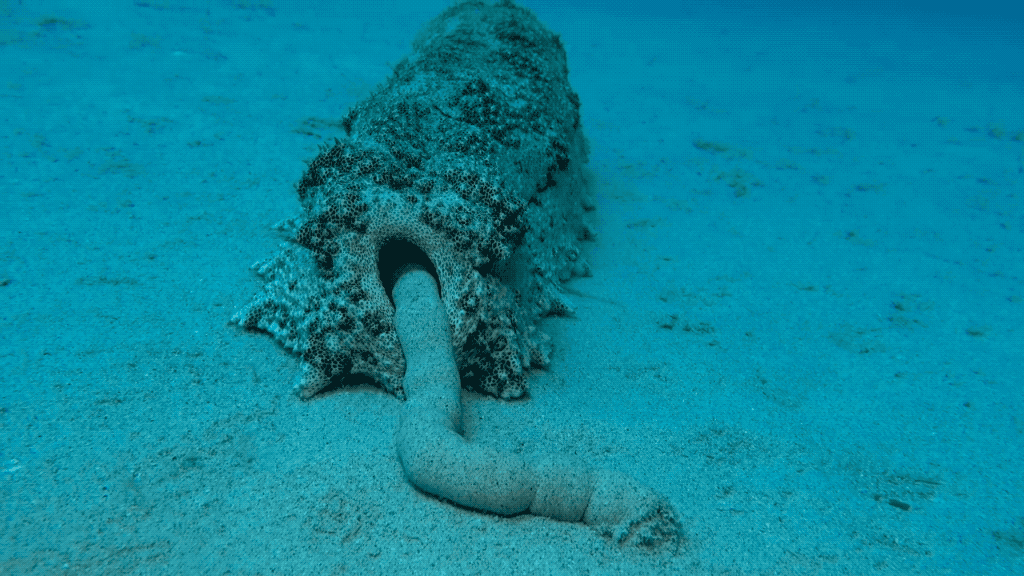Sea cucumbers pinch out '5 Eiffel Towers worth' of poop per reef, per year

Sea cucumbers — those chubby tubes of flesh that scooch around the ocean floor — have a very special talent: The tubular creatures are elite poopers, collectively expelling more than 70,000 tons (64,000 metric tons) of sandy poop out of their bottoms each year.
That's not an estimate for the entire globe; that's how much sea cucumbers poop on a single coral reef, per year. And even that tremendous number may be an underestimate, according to a new study, published Feb. 2 in the journal Coral Reefs.
In the study, scientists studied sea cucumbers living on Heron Island Reef, a 7.3-square-mile (19 square kilometers) reef with a lagoon at its center, located at the southern end of Australia's Great Barrier Reef. The team used drones to collect video footage around the edge of the lagoon, in shallow areas of the reef known as flats, and then counted the sea cucumbers caught on camera.
From these samples, they extrapolated that more than 3 million cucumbers live across all the reef flats of Heron Island.
Related: Watch this giant sea cucumber expel a spiraling poop log
Back in the lab, the team ran feeding experiments with the most abundant of the cucumber species, the black sea cucumber or lollyfish (Holothuria atra). They found that a single sea cucumber defecates about 1.3 ounces (38 grams) of poop per day, and would therefore produce about 30.8 pounds (14 kilograms) of poop per year.
So altogether, the army of 3 million squidgy sea cucumbers living on Heron Island reef produce tens of thousands of tons of poop each year, slightly more than the mass of five Eiffel Towers, the authors wrote.
Sign up for the Live Science daily newsletter now
Get the world’s most fascinating discoveries delivered straight to your inbox.
Even "this was a huge underestimate of poop, because we didn't include the reef lagoon," study author Vincent Raoult, a marine ecologist at the University of Newcastle, said in a tweet. "Imagine on a global scale" just how much poop sea cucumbers dump into their local ecosystems, he added.
Why should we care about sea cucumber poop? Their droppings are critical to the health of ocean ecosystems, particularly coral reefs.
Related: Survival of the grossest: 8 disgusting animal behaviors
Like underwater earthworms, sea cucumbers gobble up organic matter on the ocean floor, including tiny pieces of algae and marine creatures, Live Science previously reported. The digestion process breaks down this matter, releasing beneficial byproducts that get pooped out along with any indigestible sand that the cucumbers consume.
These byproducts include calcium carbonate, a key ingredient in coral formation, and ammonia, which acts as a fertilizer and promotes coral growth. Sea cucumber poop is also slightly basic, meaning it lowers the acidity of the surrounding water; less acidic conditions also help coral form their calcium carbonate skeletons, Live Science previously reported.
"Sea cucumbers turn over sediment, which can aerate the sediment and release nutrients (food) to other organisms on coral reefs," study author Jane Williamson, a marine ecologist and fisheries biologist at Macquarie University in Sydney, told Live Science in an email. If sea cucumbers didn't swallow and poop out the sediment, "these nutrients remain trapped and useless to other animals and plants."
Despite their important role in reef ecosystems, overfishing threatens sea cucumber populations worldwide. Currently, seven species are endangered and nine are "vulnerable to extinction," according to a statement from the University of Newcastle. "The reduction in density means that less sediment is turned over," Williamson said. In other words, fewer sea cucumbers mean less sea cucumber poop, which poses a potential threat to coral reefs.
In sharing their new research, the team has found that "people love the idea that poop is important," Williamson noted. "Everyone poops, so I guess it's something that people can relate to?" she said.
Originally published on Live Science.

Nicoletta Lanese is the health channel editor at Live Science and was previously a news editor and staff writer at the site. She holds a graduate certificate in science communication from UC Santa Cruz and degrees in neuroscience and dance from the University of Florida. Her work has appeared in The Scientist, Science News, the Mercury News, Mongabay and Stanford Medicine Magazine, among other outlets. Based in NYC, she also remains heavily involved in dance and performs in local choreographers' work.









